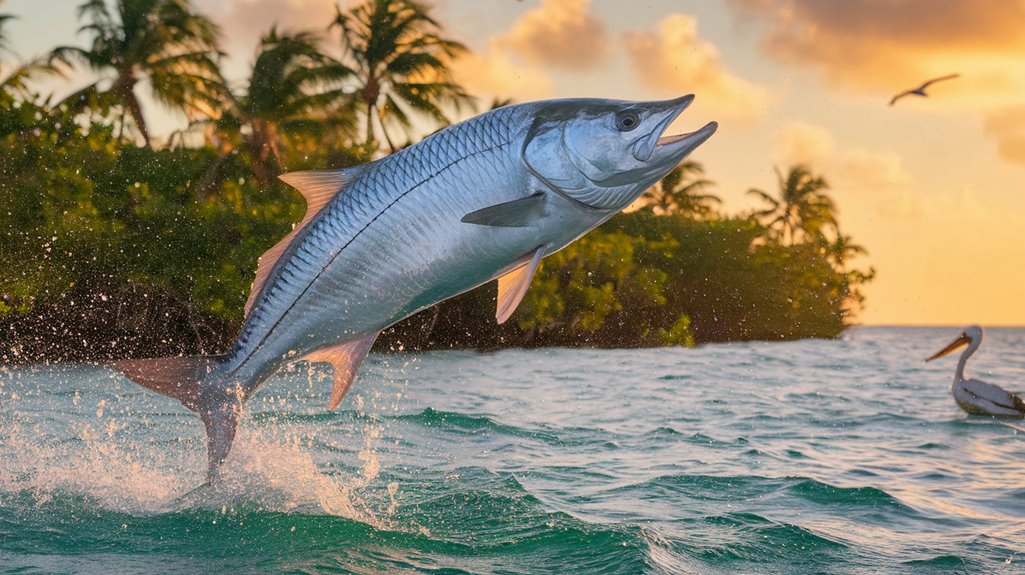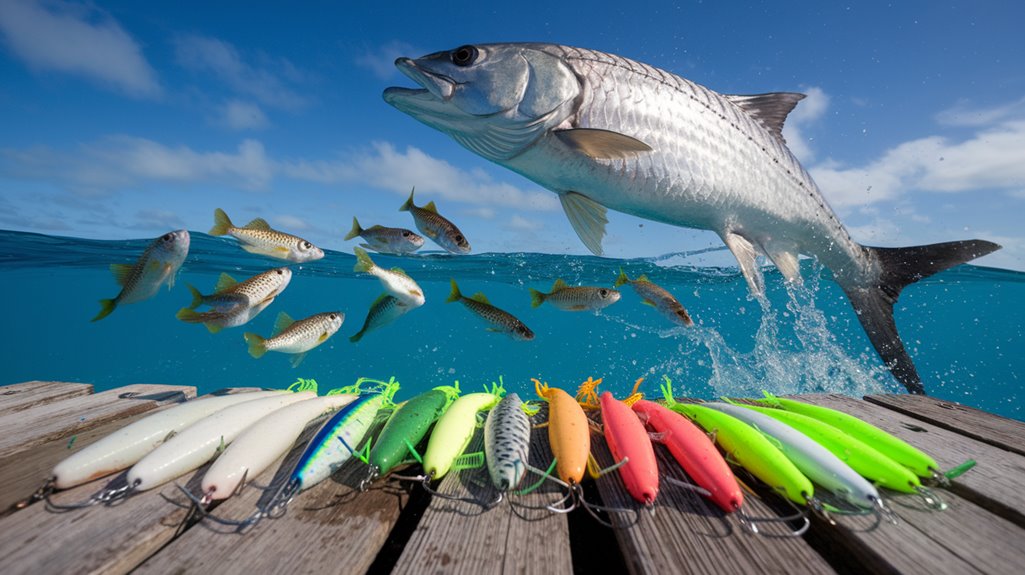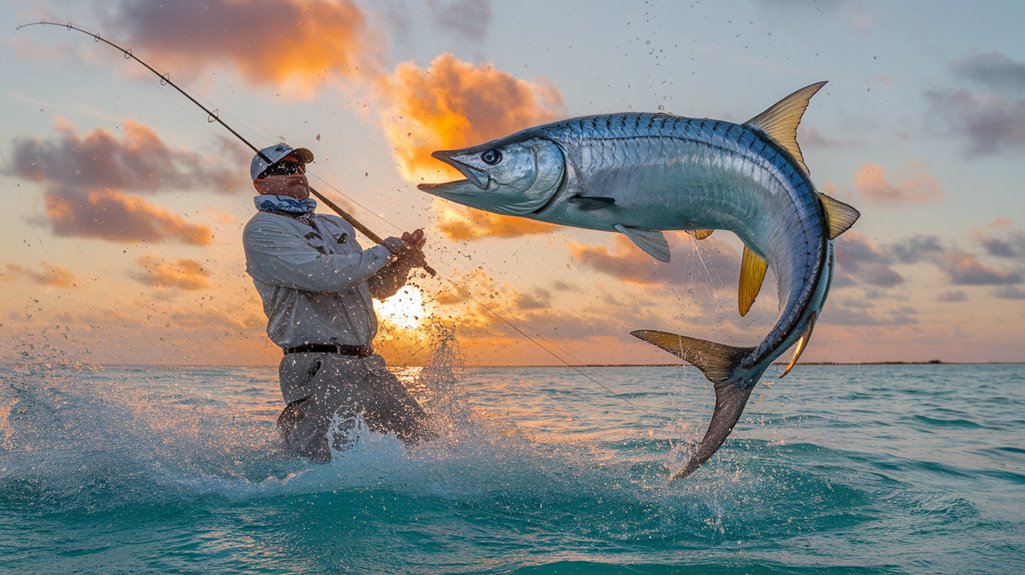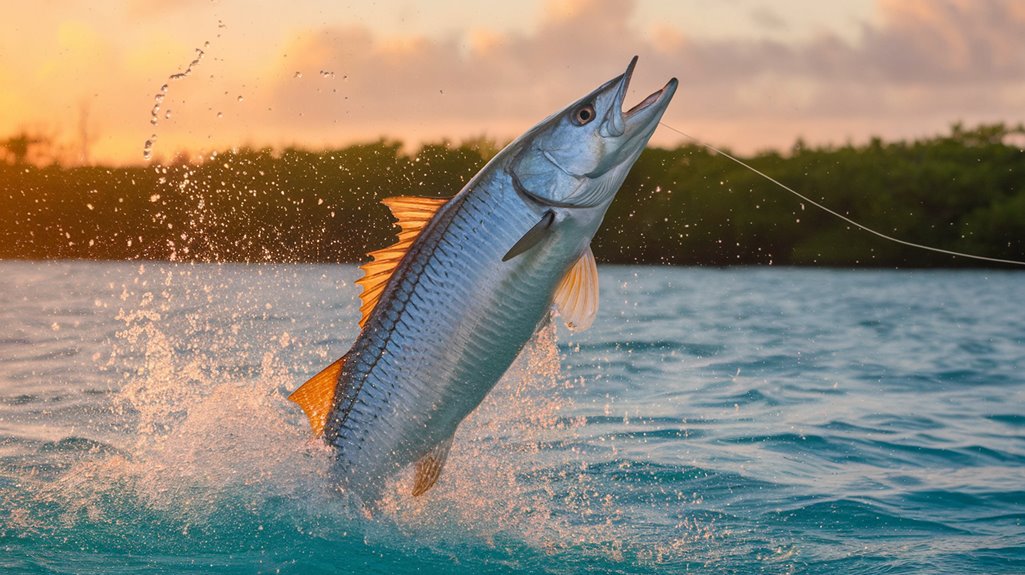You’ll find tarpon fishing in Florida to be one of the most exhilarating angling experiences available in North American waters. These silver kings, often weighing over 100 pounds, can turn a peaceful morning into an adrenaline-charged battle in seconds. Whether you’re planning your first tarpon adventure or looking to improve your success rate, understanding the essential elements of tackle, timing, and technique will dramatically increase your chances of landing these magnificent gamefish.
- Key Takeaways
- Understanding Florida's Tarpon Habitat and Behavior
- Essential Gear and Equipment Setup
- Best Bait and Lure Selection
- Proven Fishing Techniques and Strategies
- Prime Fishing Locations Throughout Florida
- Seasonal Patterns and Peak Times
- Rules, Regulations, and Conservation Practices
- Frequently Asked Questions
- Conclusion
Key Takeaways
- Fish during peak migration season from April to September when large schools enter Florida’s inshore waters, especially during moving tides.
- Use a 7-8 foot medium-heavy rod with 30lb test line and circle hooks for optimal gear setup and improved hookup rates.
- Target areas near bridges, mangroves, and structures during early morning or late afternoon when tarpon are actively feeding.
- Master the “bow to the king” technique by lowering your rod when tarpon jump to prevent line breakage and lost fish.
- Select live bait like shrimp, crabs, or mullet, positioning them up-current during ebb tide for natural presentation.
Understanding Florida’s Tarpon Habitat and Behavior

When targeting Florida’s legendary tarpon, understanding their habitat preferences and behavioral patterns is essential for success. You’ll find these magnificent fish in warm waters between 75-85°F, particularly in nearshore environments where they seek shelter around bridges and mangroves. These structures provide prime feeding opportunities for tarpon throughout their habitat.
Watch for their distinctive rolling behavior on the surface, which signals active feeding and helps you locate productive spots. During peak season from April to September, you’ll encounter more tarpon as they migrate from the Caribbean and Gulf of Mexico into Florida’s inshore waters. When you hook one, be prepared for their spectacular acrobatic jumps – remember to bow to the fish during these leaps to maintain tension and prevent losing your catch.
Essential Gear and Equipment Setup
Three critical components form the foundation of a reliable tarpon fishing setup: your rod, reel, and leader system. You’ll want a 7-8 foot rod with medium-heavy to heavy action, paired with a saltwater-rated reel capable of handling at least 30lb test line. The reel’s drag system must be robust enough to withstand the intense tarpon action during long fights.
For your leader material, opt for 20-30 pound fluorocarbon, which provides both stealth and strength. When using live or dead bait, equip your setup with circle hooks to improve hook-up rates and reduce fish injury. If you’re fly fishing for tarpon, step up to an 11 or 12-weight fly rod with matching heavy-duty reels. Choose streamers and poppers that effectively mimic the best bait – local baitfish that tarpon naturally pursue.
Best Bait and Lure Selection

Your most reliable tarpon fishing success will come from natural baits like shrimp, crabs, and live fish such as mullet and pilchards, particularly during ebb tide when positioned up-current. If you’re using artificial lures, you’ll want to focus on proven performers like Gator spoons, Mirrolure 65M/77M series, or Rapala Magnums, retrieved slowly to mimic natural prey movement. You’ll need to adjust your bait selection based on seasonal patterns, matching your presentation to the prevalent forage in the area, while ensuring your hooks match your bait choice – J-hooks for mullet and circle hooks for most other live baits.
Live Bait Proven Winners
To maximize your tarpon fishing success in Florida, selecting the right live bait can make all the difference between landing these magnificent gamefish or going home empty-handed. When fishing for juvenile tarpon, you’ll want to focus on proven live bait options and proper presentation techniques.
| Live Bait | Presentation Technique |
|---|---|
| Mullet | Use sharp J-hooks with 6-8′ leader and bobber |
| Crabs | Wait for line pressure before setting hook |
| Pilchards | Monitor rod tip for subtle strikes |
| Pinfish | Fish during ebb tide for best results |
For ideal hook and line success, let the tarpon take the bait completely before applying pressure on the fish. Remember that crabs provide easier consumption and better hook sets, while mullet work exceptionally well when presented with the right leader length during prime feeding periods.
Artificial Lure Selection Guide
While live bait consistently produces results, artificial lures offer distinct advantages for targeting tarpon in Florida waters. Your best effective options include Gator spoons, Mirrolure 65M or 77M, and Rapala Magnum. In shallow waters, you’ll want to use unweighted lures for proper presentation where tarpon are most likely to strike.
When fishing canals and river systems connected to saltwater, opt for small Rapalas and jigs that mimic natural prey. You’ll find success by varying your retrieval speed and adding occasional twitches to your presentation. To increase your chances of landing these powerful fish, equip your artificial lures with circle hooks, which provide better hook sets and help prevent lost fish during the fight.
Seasonal Bait Preferences
Understanding seasonal bait preferences is essential for successful tarpon fishing throughout Florida’s diverse waterways. You’ll find that natural bait like live shrimp and crabs work exceptionally well during ebb tides, as they mimic the prey’s natural movements. When using circle hooks with live bait, you’ll achieve better hook setting rates, especially given tarpon’s bony mouths.
- Match artificial lures like Gator spoons and Mirrolures with slower retrieval speeds for best results
- Select 3-5 inch flies that match bottom colors, adjusting your retrieval speed based on water conditions
- Choose live crabs for easier consumption and improved hook-up success rates, particularly during peak feeding periods
Remember that seasonal bait selection directly impacts your success rate, so always adapt your approach based on water conditions and tarpon feeding patterns.
Proven Fishing Techniques and Strategies

When fishing with live bait, you’ll want to position your mullet or crab up-current during ebb tide, allowing the natural flow to present your offering to waiting tarpon. You’ll need to master the “bow to the king” technique by dropping your rod tip when a tarpon goes airborne, which prevents the line from breaking during spectacular jumps. For consistent success, target areas where moving tides concentrate bait around structures, focusing your efforts during prime low-light periods of early morning or late afternoon.
Live Bait Best Practices
Successful tarpon fishing with live bait comes down to mastering a few proven techniques. When you’re ready to fish for Tarpon, set up with a bobber and 6-8 foot leader to maximize your chances at the best Tarpon fishing spots. Whether you’re using live mullet or crabs as your best bait, proper hook setting is essential for landing these powerful fish.
- For J-hooks with mullet, reel quickly and lift your rod to 45 degrees after feeling pressure on the line
- When using live crabs, wait for a steady thump before setting the hook
- With circle hooks, point your rod at the fish first, then lift the tip after a brief delay
Keep the line tight once hooked, but avoid constant reeling with dead bait – letting it rest with some slack will help you detect more strikes.
Fighting Tarpon Successfully
Landing a mighty tarpon requires a strategic blend of patience and technique throughout the fight. When you’re pulling hard against these powerful fish, start with a loose drag and gradually tighten it as the tarpon shows signs of tiring. You’ll need to bow to the King whenever it jumps by dropping your rod tip, giving the line slack to prevent the hook from tearing free.
Keep the rod at a horizontal angle while maintaining steady pressure, and frequently change your fighting position to keep the fish off balance. When you feel the initial bite, respond with a measured thump rather than an aggressive hook set. As you near the catch peak, avoid high sticking the rod, especially when the tarpon approaches the boat, as this is often when anglers lose their prize catch.
Optimal Casting Locations
To maximize your chances of hooking a tarpon, positioning yourself in prime casting locations during ideal feeding times is essential. The best locations are areas with strong currents where baitfish gather, particularly during early morning or late afternoon tides. You’ll find Tarpon around bridges, channels, and passes actively feeding in these preferred water conditions.
- Cast close to rolling tarpon, about 10-15 feet ahead of their path, allowing natural baits like live mullet to drift naturally into their feeding zone
- Focus on areas where water movement creates natural feeding stations, especially during moving tides
- Target spots where structure meets current, as these locations consistently hold fish and provide excellent casting opportunities
Remember to adjust your presentation based on the specific conditions and always be ready to answer the tarpon’s aggressive strikes.
Prime Fishing Locations Throughout Florida
While Florida’s coastline stretches for thousands of miles, several prime locations stand out as world-class tarpon fishing destinations. You’ll find excellent tarpon fishing opportunities in the Sunshine State’s diverse waterways, from the Upper Keys to Boca Grande Pass. The Everglades National Park offers year-round action, with peak season running March through July.
| Location | Peak Season | Best Time |
|---|---|---|
| Upper Keys | Mar-Jul | Ebb Tide |
| Boca Grande | May-Jun | Morning/Evening |
| Key West Harbor | May-Jul | Dawn/Dusk |
For best results, target Miami’s Government Cut during early morning hours from January to June. The Lower Keys, particularly around Key West Harbor, deliver consistent action throughout late spring and summer. Don’t overlook Bahia Honda Bridge, where tarpon frequently gather during their seasonal migration.
Seasonal Patterns and Peak Times
Understanding Florida’s tarpon migration patterns is essential for planning your fishing trips throughout the year. The peak season runs from April through September, with the most productive fishing occurring during moving tides in early morning and late afternoon hours when tarpon are actively feeding.
Key timing variations exist across Florida’s diverse fishing zones:
- Upper and Middle Keys offer prime fishing from mid-March to mid-July
- Everglades National Park provides year-round opportunities, peaking March to July
- West Coast waters, including Apalachicola Bay, excel during May and June
You’ll find large schools entering shallow inshore waters from April through June, making this period particularly rewarding. During these months, tarpon migration patterns become more predictable, allowing you to position yourself strategically for the best chances of success.
Rules, Regulations, and Conservation Practices
Before heading out for tarpon fishing in Florida, you’ll need to familiarize yourself with strict regulations designed to protect these magnificent gamefish. You must have a valid Florida saltwater fishing license and practice catch-and-release unless you’ve purchased an IGFA world record tag. To guarantee sustainability and protect tarpon populations, you can’t remove these fish from water without proper documentation.
| Requirement | Description |
|---|---|
| License | Florida saltwater fishing license mandatory |
| Equipment | Circle hooks recommended, gaffs prohibited |
| Handling | Must keep fish in water unless tagged |
| Release | Immediate release required without record tag |
Using circle hooks is vital for proper hook placement and minimizing injury. Remember, these regulations aren’t just rules – they’re essential conservation practices that help maintain healthy tarpon populations for future generations.
Frequently Asked Questions
What Is the Best Month to Fish Tarpon in Florida?
You’ll find May is Florida’s prime tarpon fishing month, as it’s when migration peaks statewide. You can catch massive tarpon in Boca Grande Pass and throughout the Keys’ shallow waters.
How to Fish for Tarpon in Florida?
Use live bait like mullet or crabs during ebb tides, positioning them up-current. You’ll want to fish early morning or late afternoon, and target areas like the Keys and Boca Grande.
What Is the Best Rig for Tarpon Fishing?
You’ll want a 20-30 pound fluorocarbon leader, 7/0-10/0 circle hook, and 6-8 foot leader length. For live bait, use a slip sinker, while artificial lures need braided line for sensitivity.
What Is the Best Bait for Tarpon in Florida?
You’ll find live shrimp, crabs, pilchards, mullet, and pinfish are your best tarpon baits in Florida. Present them during ebb tide, positioning up-current for maximum effectiveness and natural movement.
Conclusion
Armed with knowledge of tarpon behavior, proper gear, and proven techniques, you’re now ready to tackle the “Silver King” in Florida’s waters. Whether you’re casting live bait at dawn or working artificial lures near structure, remember to respect these magnificent gamefish by practicing catch-and-release. Follow local regulations, time your trips with seasonal patterns, and you’ll maximize your chances of a successful tarpon fishing adventure.

